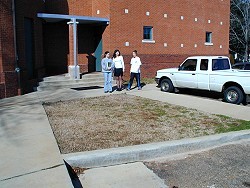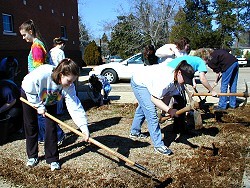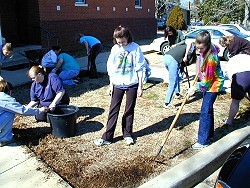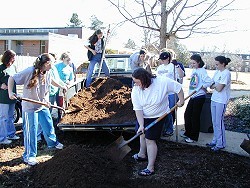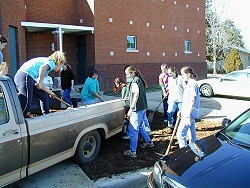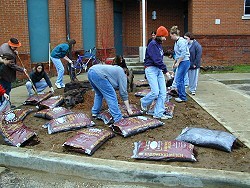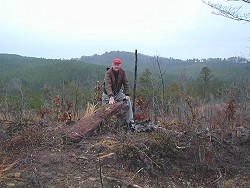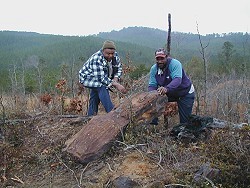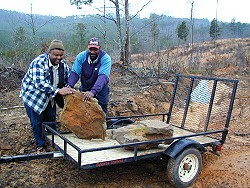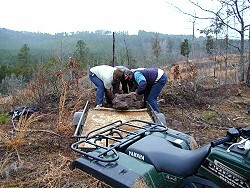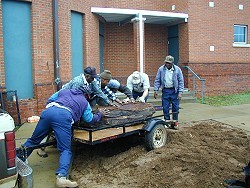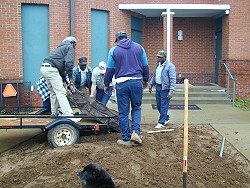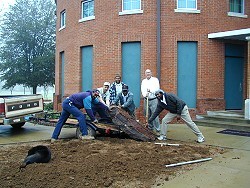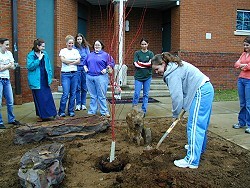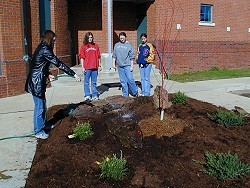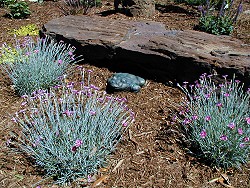|
"Groundbreaking
Botany"
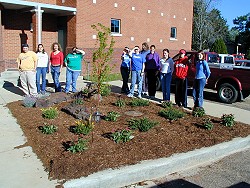 |
By Christina Ryan
Judson College,
Marion, Alabama
Spring 2003
|
Imagine a small, grassy plot of land, an island of life
in a concrete sea. Would it be called boring, or full of exciting potential?
Now imagine that plot is on Judson's campus. It would be called the newly
adopted project of Dr. Wilson's botany class. The purpose of their project is
to make a small piece of Judson friendlier to the human eye, as well as to
butterflies, and to hopefully learn something along the way. After obtaining
permission from Dr. Tew and Mr. Clements, the class discussed how to create a
better image for the fifteen-square-feet plot on the east entrance of the
Lowder science building.
The students donned their best work clothes and arrived on the
scene the afternoon of February 12, 2003, ready to get their hands dirty. With
pick, hoe, and shovel in hand, they eyed the bare, mundane square of grass.
Soon, they were ripping it up by its roots! Dee Turney observed, "When
operating a pickaxe, it is wise for one to wear shoes other than flip-flops."
Once the grass was clear, Dr. Wilson backed a truckload of sandy
laom dirt from Blackburn's Bottom in East Perry County up to the newly exposed
earth, and the students began to unload and spread it over the little plot.
"It is exciting to have a project that is both fun and
educational. We are learning applied botany, biology, and many principles of
landscaping. It is rewarding as a teacher to see so much enthusiasm from
students," reported Dr. Wilson.
March 4, Dr. Wilson led an expedition in the late afternoon mist
to collect the decorative landscaping stones for the plot with recruited
strong-arms, Ricky Clements and several men on the Judson maintenance crew.
Mr. Clements drove his 4-wheeler with a small trailer attached
to its bumper up the treacherous, eroded hillside of northeast Perry County to
the location of the best landscaping stones, where they were loaded onto the
trailer by Lee Andrew Mims, Leroy Miree, Alvin (Big D) Cannon, and James Huey.
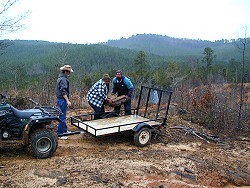 |
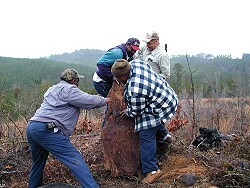 |
The largest stone weighed an estimated 600 pounds. It was a test
of strength and determination to get it on the trailer. The landscaping stones
served as a bonus lesson in geology for our botany class. Dr. Wilson informed
us that the stones were created 350,000 years ago by the last Pleistocene
period, which resulted in ridge uplift and the exposure of layers of ancient
sandstone ledges. The rich earth-toned ribbons of color in the stones are due
to their impregnation with dark minerals carried by numerous glacial rivers at
the end of several ice ages. Dr. Doug Jones, Geology Department Head,
University of Alabama, Tuscaloosa, explained the details of our stones' history
in a conversation with Dr. Wilson.
With the help of the Judson maintenance grew, the stones were
arranged and placed in the garden the next morning.
That afternoon, the botany students surveyed the layout and
proceeded to install the project's centerpiece, a Japanese coral bark maple. It
is a relatively small tree that expresses itself in unique ways during
different seasons. At the time of planting, it had no leaves, but the bareness
of the branches emphasized the beautiful florescent pink bark, reminiscent of
coral. In the spring the bark will fade, and the tree's green leaves will
display "painted" red margins. These will last through the summer and turn
golden in the fall.
While planting, the botany students learned valuable applied
botany lessons, such as what ratio the planting hole dimensions should be and
the top reason for watering a tree immediately after planting it (even in the
wet winter this is important to settle the dirt around the tree, so that the
roots will not be exposed to air pockets). After the tree was planted, the
students admired their work as they saw it begin to take shape.
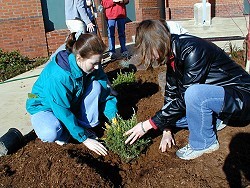 |
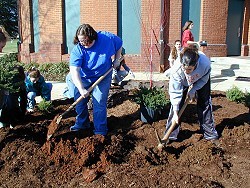 |
Botany student, Jennifer Moore, purchased a load of hardwood
mulch and brought it to the garden spot. All the students mulched the muddy
plot the morning of March 7 as Dr. Wilson lectured on the top reasons for
mulching. On The morning of March 10, more plants were added. "I'm getting dirt
under my painted fingernails!" remarked Delisa Gillon as she planted a dwarf
Juniper. Juniperus squamata is a low-growing, gray-green evergreen shrub. Sweet
broom, another plant that was added, is a favorite of butterflies with its
fragrant, yellow, pea shaped flowers. Dianthus (pinks) produce richly fragrant
flowers in the spring or summer. We also added some purple fountain grass,
which is a natural contrast to the reddish stones.
Mr. Wisenhunt critiqued the project favorably, saying, "It has a
good variety of textures and a diverse color palette." He particularly liked
the monolith position of one of the stones. The class anticipates adding some
other butterfly-attracting plants.
|

